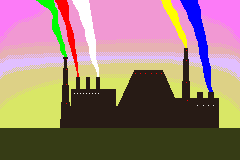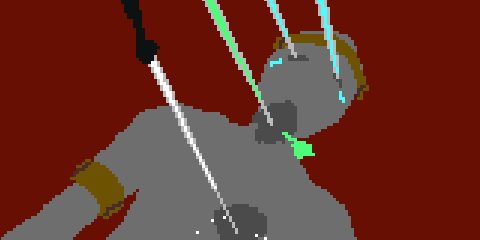Pigment Factory
Warning! This article contains dark themes such as slavery, torture, and brainwashing. The fragments of text referencing those themes are hidden under spoilers.
Depending on the age of the factory the amount of the chimneys it possesses varies. The older structures usually possessed one great chimney, where all of the Colors mixed, with smaller chimneys branching out of it. This model has been abandoned quite quickly as maintaining the right mixture of all Colors as to neutralize them was almost impossible and often led to the creation of various dangerous blends.
The modern factories possess at least six different chimneys, one for each Color, with an air ventilation system capable of separating them into corresponding chimneys. As such, Colors, in their pure form, are pumped out back into the atmosphere. There are at least two entrances to the building, one for the production line workers, the second one for office workers.
This process is undergone as to not risk the accumulation of Colors both during and after work hours. After leaving this room, the workers go to the locker room where they can put on their protective uniforms.
Nine silhouettes left the city.Pigment factories, workplaces of hundreds of people, sources of Pigments, and wonders of the technology from the times of the Age of War.
The suns wouldn't rise for another 2 hours, so they marched in almost complete darkness. They had to hurry, otherwise innocent lives would be at risk.
They were getting closer to their goal. An enormous, metal structure stood before them. At this hour it was almost completely black. Only a dozen or so of white and red lights illuminated its walls. Colorful pillars of smoke spilled out from its numerous chimneys. As the nine of them approached the building, the smoke stopped.
A loud whistle could be heard from inside. They were right at the time, the night shift just ended. According to their intel, before the day-shift workers would come, an hour passes. It would be like that because the machines within needed some time to cool down. And that's when they could strike. They put on their gas masks, sealing their Colorproof suits and one of them ran off to plant the explosives.
The outside
As inefficient as it may seem, the outer walls of Pigment factories are almost completely made out of three layers of metal panes. The outer layers serve as reinforcement, while the one inside, made out of the sponge iron, serves to stop any spills of the Colors to the outside world. The metal alloys used in the outer layers give the facility a dark, somber look.Depending on the age of the factory the amount of the chimneys it possesses varies. The older structures usually possessed one great chimney, where all of the Colors mixed, with smaller chimneys branching out of it. This model has been abandoned quite quickly as maintaining the right mixture of all Colors as to neutralize them was almost impossible and often led to the creation of various dangerous blends.
The modern factories possess at least six different chimneys, one for each Color, with an air ventilation system capable of separating them into corresponding chimneys. As such, Colors, in their pure form, are pumped out back into the atmosphere. There are at least two entrances to the building, one for the production line workers, the second one for office workers.
The inside
The explosives went off. The wall of the factory was torn apart. They were in."
Purging chamber
The first area the workers enter during the start of their shift, purging chambers, serves to decontaminate them both during the entry and upon leaving the facility.This process is undergone as to not risk the accumulation of Colors both during and after work hours. After leaving this room, the workers go to the locker room where they can put on their protective uniforms.
The sorting machines
The objects, from which the Pigments will be harvested, are first sent through the sorting machines. Those machines detect the levels of Colors within the objects and allocate them to the correct conveyor belts to maximize the amounts of possible harvest. As of today, this process has been almost completely automated.The production line
Here all of the objects are harvested. The area is always filled with workers, some injecting and removing the needles used in extraction, others observing the process of crystallization or final treatment of the Pigments.The grinders
The end-point of the production line. All of the objects, Gray and completely drained, are sent to the grinder. As most of the items that become Gray loses its previous properties and becomes brittle, the grinders turn them into dust, which then can be safely disposed of.Sad reality of factories
Second warning! This section contains dark themes of slavery, torture, and brainwashing.
Even during the Age of War, it was quickly discovered that extracting the Pigments from the dead animals and inorganic materials were quite ineffective. Even the animals, which don't absorb the Colors that good, weren't the answer for ever-growing demand. That's why, in times of great need and closing conflict, both prisoners of war and slaves were used as sources of Pigments.
Because sapient races (especially Humans and Huerustlers) absorb the Colors thorough their whole life and store them within Color Nests, keeping them alive creates a renewable source of Pigment. And in case a lot of it is needed in a very short time, exposing the "donors" to large amounts of Colors makes the production speed up even more.
Even if after such "enrichment" the number of trucks leaving the factory increases.
The same goes for the grinders, however, some factory owners like to have a place where they can dispose of the bodies of the deceased.
The biggest change would be the installation of the systems pumping the gas into the working area. With the right mix of the breathing air and aerosol made out of Blue Pigment both the "donors" and the workers can be kept in a euphoric, brainwashed state. After the shift ends, the workers get cleansed, and all that they remember is a nice day at work.
Because sapient races (especially Humans and Huerustlers) absorb the Colors thorough their whole life and store them within Color Nests, keeping them alive creates a renewable source of Pigment. And in case a lot of it is needed in a very short time, exposing the "donors" to large amounts of Colors makes the production speed up even more.
Even if after such "enrichment" the number of trucks leaving the factory increases.
Alterations of the structure
When repurposing the factory to the harvest of sapient races, some alterations are needed. For example, the sorting machines are no longer needed and that opens up the place for where the fresh "donors" can be stored or to increase the area of the production line.The same goes for the grinders, however, some factory owners like to have a place where they can dispose of the bodies of the deceased.
The biggest change would be the installation of the systems pumping the gas into the working area. With the right mix of the breathing air and aerosol made out of Blue Pigment both the "donors" and the workers can be kept in a euphoric, brainwashed state. After the shift ends, the workers get cleansed, and all that they remember is a nice day at work.
No matter how many times they have seen it, the sight was terrifying. The whole area was filled with Blue gas. Suspended on the hooks and tied to the tables were people, almost completely drained of Colors. Their bodies injected with numerous needles. Some of them could still be saved. For others, death would be the only merciful end.
The leader of the group made a few hand signals and all of them split up into groups of two. The two of them guarded the entrance. Another two guarded the hole in the wall their explosives created. Soon, a vehicle would drive up and they needed to protect it. The next two started to free the people imprisoned here. The last group, the only one that consisted of three people, started sweeping the building. First, they went along the production line, seeing more and more victims of the factory. Going through the door in a thin partition wall they reached the final part of the production line. The grinder. The sight was gruesome. The walls and floor forever colored (or de-colored) with transparent fluids, ones they could only guess that once were the blood and guts.
The leader sent one of his people to sabotage the mechanism. This side was clear. There was one room still left to check. The room they wanted to leave for the last. They came back to the rest of the group and went for the room that once was a warehouse. If not for their gas masks, the stench of bodily fluids and rotting flesh would be overwhelming. Inside the room, there were a few emaciated people laying between the tens of corpses, all drugged up by illusionary properties of the Blue gas.
Taking away the factory prisoners took them most of the break in the shifts of the facility.
As they drove away from this wretched place, they finally could take off their gas masks.
Before leaving, they left a little explosive surprise in the meeting room and the office of the owner of the factory.
Another small victory for the resistance. So why did it feel so bitter?
Alternative Names
Color Factory, Hue Factory
Type
Factory
- Zetalph's great complex - A factory complex, half of the size of the Zetalph's capital-city.
- Factory of the Green Nowhere - A once great factory, destroyed by the pressure of the gases inside the ventilation systems. The main Color processed there, Green spilled out everywhere due to the explosion, oversaturating and warping the surrounding area.
Pigment extraction
Pigment factories work at full throttle in order to produce the highest quality of pigments. The method of extracting them hasn't changed for over two centuries, but the tools used to carry out the said process are constantly upgraded. During the process, a set of long needles made out of Sponge iron is inserted into inorganic or organic material. The sponge iron used in their creation is dyed with the Color other than the one that needs to be extracted. This is to prevent the Color from spilling outside. Additionally, within the needle, there is a small piece of undyed condensed sponge iron. Thanks to absorptive properties of sponge iron, the Colors are pumped farther into the apparatus, where they go through an "energetic desublimation", filtration, and crystallization.The crystallized Colors are then ground into dust, the most common form of Pigments. Any fumes resulting from those processes are pumped out through the air ventilation system and leave the facility through the chimneys as colorful smoke.
The warehouse
In times of the lowered demand, all of the objects awaiting the harvest are stored within secured warehouses neighboring the sorting room.This room is checked very often for any increased levels of Colors. In case of any irregularities, specialists are sent inside.




Soilent green (and every other color for that matter) is PEOPLE!
Yeah, pretty much :D